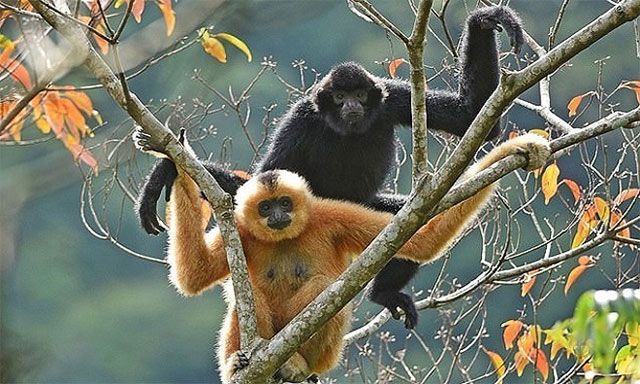Discover the pair of apes of the rarest primate species in the world
Hainan Gibbon is only found on the island of the same name of China with fewer than 10 species worldwide in the 1970s. However, after half a century of conservation, the number of primate species is the rarest The world has gradually increased to more than 30. Pair of male and female Hainan gibbon discovered in a new stretch of forest. Experts from the Hai Nam Gibbon Conservation Project think they are breeding and forming the fifth family on the island.

A pair of gibbon will help the number of Hai Nam gibbon continue to increase. (Photo: MSN).
A pair of apes are reproducing very easily from afar because the male is pure black while the female is yellow. They are also animals that possess extremely loud cries, often emitting a loud noise to mark territory. These calls can be doubled as a way for male and female gibbons to strengthen their bond by singing sometimes dawn. New pairs of gibbon were also discovered through the call and the patrol team later confirmed their existence.
The development of the pair of Hai Nam apes is extremely important in the fight to prevent extinction in this species. The long-lived tree gibbon nearly died out in the 20th century due to habitat loss and poaching. Because of habitat encroachment on farms, the number of Hai Nam apes decreased from 2,000 in the 1950s to about a dozen in 1970. In 2003, the survey found only 13 individuals living in Naturally, promoting the Kadoorie Botanical Garden in Hong Kong established the Hai Nam Gibbon Conservation Project. The project team expects that the number of new gibbon species will continue to increase. According to conservationist Philip Lo, this is encouraging news for the project.
However, many other apes are still facing extinction. Hai Nam Gibbon is the only one of the 19 species of gibbon in the world that has a steady growth. But they are still on the "extremely endangered" list of the International Union for Conservation of Nature (IUCN). If the total number of Hai Nam apes exceeds 50, IUCN will transfer them to the "endangered" list. In 2007, Hai Nam gibbons concentrated in a forest area of 15.5 km 2 without figs and litchi, their favorite fruits. Conservation experts have planted thousands of new trees, regularly patrolled the area, conducting research to learn more about their ecology and behavior.
- Giant ape species in prehistoric Southeast Asia
- Discover the world's rarest rabbits in Vietnam
- The strange skull of ancient apes reveals the secret of how the primates' brains grow
- New fossils show primates that have ancestors in Asia
- Primate animals also nest
- The tragedy of Vietnamese primates
- Seagull is the rarest in the world
- The world's rarest spider species faces the risk of extinction
- The first film about the rarest whale on the planet
- 'Take advantage of' the beauty of one of the world's rarest flower species
- The least known close-up picture of the whale in the world
- The dam will make the Mekong catfish extinct
 Animal 'suffering' after hibernation
Animal 'suffering' after hibernation Why do goats climb well?
Why do goats climb well? Scientists were surprised to see chimpanzees eating turtles
Scientists were surprised to see chimpanzees eating turtles Giant catfish died deadly due to drought in Thailand
Giant catfish died deadly due to drought in Thailand